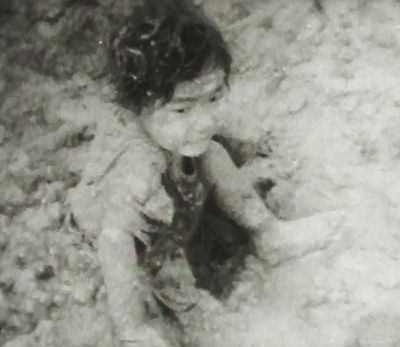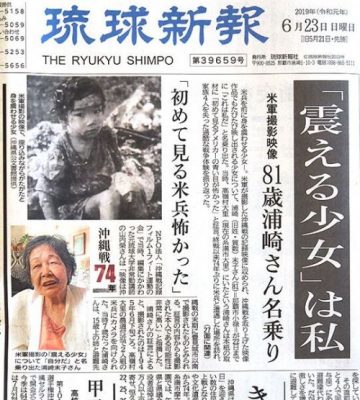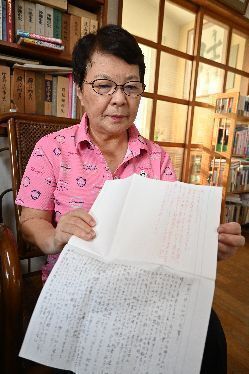Woman who spoke about the Battle of Okinawa as the “Trembling Girl” harassed at home by unknown male visitor
June 26 2020 Ryukyu Shimpo
By Yosuke Anri
Sueko Urasaki, 82, who came forward as the “trembling girl” in an image from the Battle of Okinawa, was, according to sources contacted on June 25, visited by a man who made accusatory remarks doubting her story. Urasaki has been avoiding contact with the outside for the past year. There have been other similar incidents involving the individuals who testified to the mass forced suicides in Zamami during the battle. The lasting inheritance of the Battle of Okinawa has become a topic of late, and someone familiar with the effort to suppress the testimonials of survivors raised the alarm bell, saying, “We cannot allow survivors to become hesitant, hindering the lessons to be passed down from the battle.”

The trembling girl captured on film by the U.S. military (provided by the Okinawa Prefectural Archives)
According to a relative of Urasaki, the unknown man appeared at her home around August of last year. When Urasaki opened the door, he asked, “Are you Ms. Urasaki” before suddenly pulling close and saying “What are you trying to do?”

The 2019 Ryukyu Shimpo article “I am the trembling girl” in which Sueko Urasaki came forward as the girl in the picture
The Ryukyu Shimpo had reported in the June 23 morning edition of last year that Urasaki had come forward as the “trembling girl” in a photo taken by the U.S. military after the battle. Since the man was not an acquaintance, she felt, “He must have come to criticize me for appearing in the paper.” Terrified, she began refusing visitors and refrained from going outside. Her relatives reflected, “Reliving the Battle of Okinawa was painful. She felt that the man’s intention was to prevent her from spreading her story.”
There were also incidents of people trying to suppress stories about the Battle of Okinawa in the past as well. Harumi Miyagi, 70, an Okinawan women’s history researcher who compiled her mother’s notes about the compulsory suicides in Zamami, has received hate mail, threatening phone calls and unwanted visitors to her home.
Miyagi’s book was used as evidence when Japanese commanding officers from the battle filed a lawsuit against author Kenzaburo Oe and Iwanami Publishing for his descriptions of the compulsory suicides detailed in his book, Okinawa Notes, supporting their claim that, “They had given no such order.” Miyagi did not intend her writing to be supportive of the officers’ case, and released a new edition of her book that indicated “military orders” and the “compulsory nature” of the suicides.
In response to this move, supporters of the commanding officers called her place of work throughout June and July of 2006, demanding that “[She] be fired immediately” and sent her letters demanding she apologize to the former officers.

Harumi Miyagi holding one of the threatening letters sent to her place of work
In August of 2014, upon learning of the death of one of the former officers, a female journalist paid a visit to Miyagi in her home. They showed her an image of the former office crying as a “message”, then a man accompanying the reporter said, “You cannot write another book.” When the journalist was asked for comment by this newspaper, she said the purpose of the visit was for an “interview’ and that “showing her the image had no deeper meaning, it was just business as usual. I was certainly not a threat.” However Miyagi claims, “It was certainly intended to try and keep me silent.”
In September of 2007, when a citizens committee was held to demand that the Japanese government retract their decision to downplay the Japanese military’s role in mass suicides, a survivor of the suicides in Zamami was visited at home by two men clad entirely in black who demanded to know “Were you really there?” The survivor reflected, “I was unable to speak,” but the fear stuck with them. They said of that time, “They meant to scare me to keep me silent. I have not forgiven them, but I refrained from making the incident public so as not to further incite them.”
(English translation by T&CT and Sam Grieb)
Previous Article:Little terns: Nurturing love in material storage area
Next Article:LDP heavyweight Shigeru Ishiba says Henoko relocation is “not the only solution”
[Similar Articles]
- Woman claims to be the iconic “trembling girl” in war footage
- 72 years after the US military landed on Zamami Island, villagers honour victims of “Group self-determination” and vow never to repeat war
- Group hoping to correct Chibichiri Gama omission from textbook protests against recent cave vandalism
- Medoruma’s In the Woods of Memory to be first Okinawan novel published as stand-alone English book
- Editorial: 75 years after U.S. landing on Kerama, remember the past for a peaceful future
 Webcam(Kokusai Street)
Webcam(Kokusai Street)


